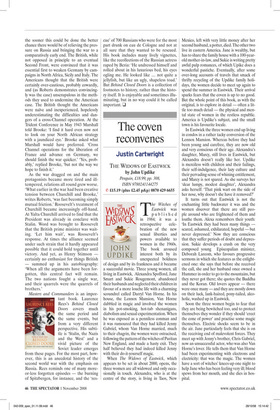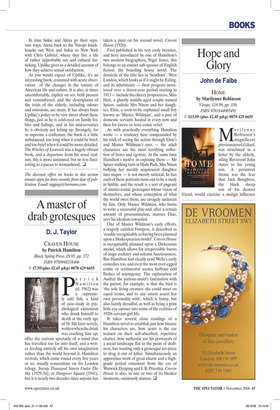The coven reconvenes
Justin Cartwright
THE WIDOWS OF EASTWICK by John Updike Penguin, £18.99, pp. 308, ISBN 9780241144275 ✆ £15.19 (plus £2.45 p&p) 0870 429 6655 The Witches of Eastwick was published in 1984; it was a retrospective celebration of the new sexual liberties and powers available to women in the 1960s. The book aroused interest both by its unexpected boldness of design and by its frankness and it became a successful movie. Three young women, all living in Eastwick, Alexandra Spofford, Jane Smart and Sukie Rougemont, abandoned their husbands and neglected their children in favour of a more louche life with a charming scoundrel called Darryl Van Horne. In his house, the Lennox Mansion, Van Horne dabbled in magic and involved the women in his pot-smoking, hot-tub shenanigans, diabolism and sexual experimentation. When he was exposed as a penniless conman and it was rumoured that they had killed Jenny Gabriel, whom Van Horne married, much to their chagrin, the women were ostracised, following the pattern of the witches of Puritan New England, and made a hasty exit. They half believed they had indeed killed Jenny with their do-it-yourself magic.
When The Widows of Eastwick, which appears to be set in about 2000, opens, the three women are all widowed and only occasionally in touch. Alexandra, who is at the centre of the story, is living in Taos, New Mexico, left with very little money after her second husband, a potter, died. The other two live in eastern America. Jane is wealthy, but has to share the family house with a 100-yearold mother-in-law, and Sukie is writing pretty awful pulp romances, of which Upike does a wonderful pastiche. Eventually, after some over-long accounts of travels that smack of thrifty recycling of the Updike family holidays, the women decide to meet up again to spend the summer in Eastwick. Their arrival sparks fears that the coven is up to no good. But the whole point of this book, as with the original, is to explore in detail — often a little too much detail — the physical and mental state of women in the restless republic. America is Updike’s subject, and the small town is his favourite locale.
In Eastwick the three women end up living in condos in a rather tacky conversion of the Lennox Mansion. Whereas before they had been young and carefree, they are now old and very conscious of their age. Alexandra’s daughter, Marcy, still lives in Eastwick, but Alexandra doesn’t really like her. Updike is merciless with children and their failings, their self-indulgence, their lazy culture and their pervading sense of whining entitlement, and Marcy is not spared. As she surveys her ‘dear lumpy, modest daughter’, Alexandra asks herself: ‘That pink wart on the side of her nose, why doesn’t she have it removed?’ It turns out that Eastwick is not the enchanting little backwater it was and the women discover that there are still people around who are frightened of them and loathe them. Alexa remembers their youth: ‘In Eastwick they had been many things — scared, ashamed, exhilarated, hopeful — but never depressed.’ Now they are conscious that they suffer periods of doubt and depression. Sukie develops a crush on the very composed young Episcopalian minister, Deborah Larcom, who favours progressive sermons in which she features as the enlightened one: she says that before she received the call, she and her husband once owned a Hummer in order to go to the mountains, but they never got there; she quotes the Buddha and the Koran. Old lovers appear — there were once many — and they are mostly down on their luck, lank-haired, pony-tailed, alcoholic, washed up in Eastwick.
Soon the three women begin to fear that they are being bewitched too, and to protect themselves they wonder if they should ‘erect the cone of power’ and practise some magic themselves. Electric shocks seem to be in the air. Jane particularly feels that she is on the receiving end of malevolent forces. They meet up with Jenny’s brother, Chris Gabriel, now an unsuccessful actor, who was also Van Horne’s lover. He tells them that Van Horne had been experimenting with electrons and electricity: that was the magic. The women have a sort of witches’ knees-up one night to help Jane who has been feeling very ill; blood spews from her mouth, and she dies in hospital. In time Sukie and Alexa go their separate ways, Alexa back to the Navajo knickknacks out West and Sukie to New York with Chris Gabriel, where they live a life of rather improbable sex and cultural listticking. Updike gives us a detailed account of how they achieve sexual satisfaction.
As you would expect of Updike, it’s an interesting book, crammed with acute observation of the changes in the texture of American life and culture. It is also, at times uncomfortably, explicit on sex, both present and remembered, and the descriptions of the trials of the elderly, including odours and emissions, are many. It has always been Updike’s policy to be very direct about these things, just as he is cold-eyed on family foibles and failings, and in his mid-seventies he is obviouly not letting up. Strangely, for so supreme a craftsman, the book is a little unbalanced, too long when it could be brief, and too brief when it could be more detailed. The Witches of Eastwick was a hugely vibrant book, and a departure from his usual realism; this is more autumnal, but no less fascinating as a paean to womanhood. ❑



































































































 Previous page
Previous page